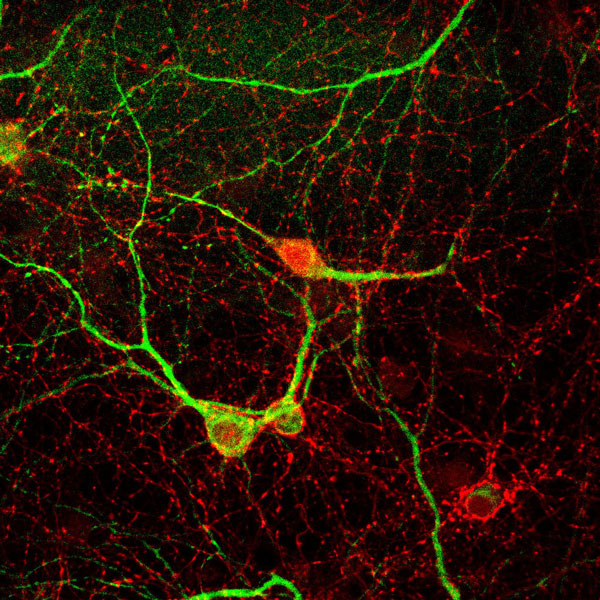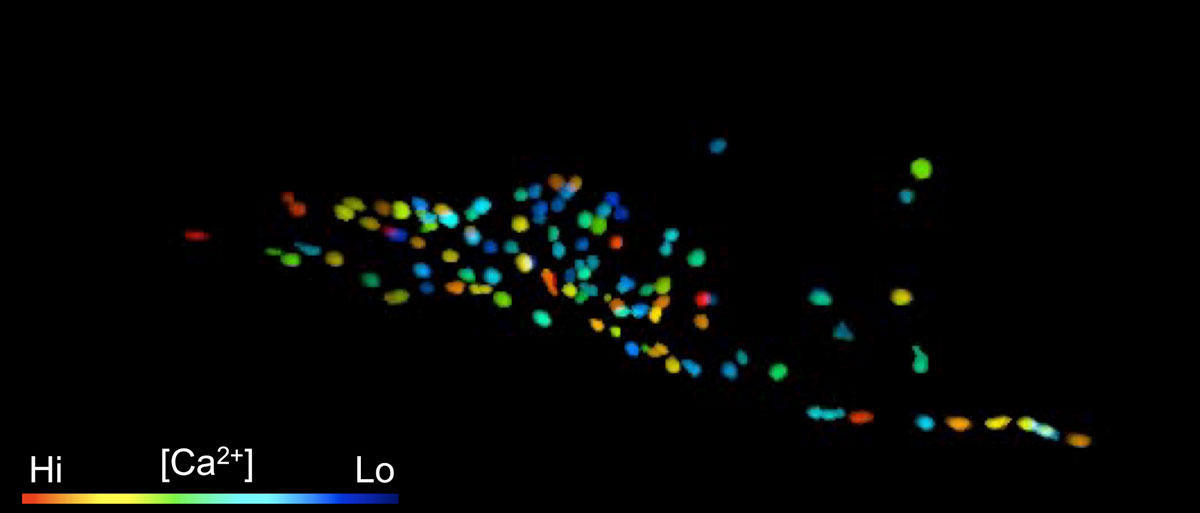
HOME / Departments / Biology
Biology
Research
The Department of Biology is engaged in various fields of biology including molecular, cellular and population biology. Diverse aspects of modern biological sciences are studied employing a wide range of innovative methods. Advanced research is carried out in close cooperation with the Department of Molecular Biology of the Faculty of Medical Science.

Education
Undergraduate School
The Department of Biology offers basic lecture courses and experimental training focused on basic and modern biology areas; both of which have seen dramatic developments in recent years. The department is mostly concerned with educating students as professionals for the life sciences and related fields. Lectures and experimental training encompass animal physiology, developmental biology, plant physiology, ecology, genetics, molecular genetics, biophysics, biochemistry, mathematical biology, cell biology, and marine biology.
Graduate School
Our Graduate School of System Life Science has two courses; the “Division of Molecular Life Sciences” and “Division of Biological Sciences”.
Division of Molecular Life Sciences

he eukaryotic cell is a core structural unit that constitutes the bodies of higher organisms, and operates various activities of life with highly sophisticated membrane structures. The Division of Molecular Life Sciences conducts research into the integrated biology of animals and plants from basic structures of genes to high-order functions of bodies by focusing on the following aspects; mechanisms of chromosomal DNA replication for maintaining genome structures, molecular dynamics of high-ordered structures from protein complexes to organelles managing cellular functions, for example, signaling mechanisms of cell-cell communication for cell proliferation, cell formations and metabolism regulation mechanistic features of functions in individual bodies including development and differentiation, and formation of neural networks and immune systems. We also provide basic lectures to students concerning other divisions aiming to understand molecular biology of life from molecular, cellular and individual aspects. The lectures include basic structures and functions of the cell, developmental mechanisms of individual bodies from fertilization to highly organized cell societies, and the coordination of nerve systems to manage high-ordered biological activities.
Division of Biological Sciences
Recent developments in ecology and evolutionary biology provide us with better tools to investigate interactions among individuals and the coexistence of species within ecosystems. Similar advances in other branches of biology have likewise led to improved knowledge and techniques. At the individual level of cell developments in physiology we have refined our methodologies of analyzing biological phenomena. Comparable advances in molecular biology have enhanced our knowledge of genomes and clarified the details of mechanisms underlying physiological processes.
The current requirement is to integrate all such developments to investigate interactions between organisms and their environments, and to deepen our understanding of the mechanisms underlying various biological attributes found between individuals and populations.
With this in mind, our study areas include 1) perceptions of, and responses to, environmental stimuli in animals, 2) reception of, and responses to, light in plants, 3) adaptive strategies in reproduction and social structures in organisms, 4) establishment and maintenance of community structures in marine organisms, 5) molecular evolution and the maintenance of genetic diversity, and 6) mathematical aspects of complex biological phenomena.
With this focus we aim to integrate biological knowledge from the molecular, cellular, individual and population levels. By participating in research in our division, students can learn how to conduct cutting-edge research on mechanisms of animal and plant responses to environmental stimuli, ecological interactions between organisms and environments, and the generation and maintenance of biodiversity.

Research Groups
Division of Molecular Life Sciences
- Animal Developmental Biology and Reproductive Engineering
- SAITO Daisuke, Professor
- ATSUTA Yuji, Lecturer
- HAYASHI Yoshiki, Lecturer
- Germ cells are the sole and fundamental cells to leave offspring. Although germ cells in an animal body would be strictly regulated to avoid aberrant proliferation, cell death, and differentiation due to its biological significance, the regulatory mechanisms of germ cells have been largely unknown. To address the issues, we study the developmental mechanisms of germ cells in vertebrate embryos, focusing on the cellular and molecular interactions between germ cells and environmental somatic cells, in the contexts of germ cell maintenance and migration. We progress these researches by maximizing the advantages of avian system including in vivo high quality imaging, cell/tissue transplantation, germ cell culture, and transgenic chickens and quails. In addition to basic developmental researches, we are also interested in various applications of avian reproductive engineering.
Read More
- Functional Cell Biology
- TERAMOTO Takayuki, Associate Professor
- NAKAJO NobushigeI, Lecturer
- YAMAWAKI YoshifumiII, Lecturer
- IMAFUKU YasuhiroIII, Assistant Professor
- OKUMOTO KanjiIV, Assistant Professor
- SHIBATA Toshio, Assistant Professor
-
- We are interested in cell-cycle control in early development and cell differentiation. Accordingly, we are investigating the cell cycle, signal transduction, cell growth, and cell differentiation in early development, using the amphibian Xenopus system.
- Insects having "micro-brain" show various sophisticated behaviors. Especially, the praying mantis catches a moving prey by adjusting its foreleg movements depending on the prey position. How the central nervous system transform sensory information into motor commands is one of fundamental questions in neuroscience. We address this question by observing neural structures in the mantis brain and recording neural responses frombehaving mantises.
- Short-term synaptic plasticity (SSP) comprises several synaptic processes that operate on millisecond-to-minute timescales and modulate synaptic efficacy in a way that reflects the history of presynaptic activity. We are investigating SSP of frog neuromuscular transmission to clarify the roles of SNARE proteins by mathematical approach.
- Intracellular organelles are highly organized in eukaryotic cells and fulfill a wide variety of cellular functions. To elucidate molecular mechanisms underlying specific protein import into the target compartments, organelle biogenesis, and regulation of organelle functions is one of the major tasks in cell biology. We are tackling these issues by using peroxisome, a single membrane-bounded essential organelle, as a model compartment in mammalian cells.
Read More
- Plant Molecular Biology
- NEGI Jyuntaro, Associate Professor
- MATSUDA Osamu, Assistant Professor
- At the Laboratory of Plant Molecular Biology, the functions of plant cells related to environmental adaptability are studied using genetic engineering approaches. Our efforts focus on the model plants Arabidopsis and rice. The objective is to characterize the key genes involved in the adaptation of plants to stress factors such as temperature, CO2, and pathogen invasion. By analyzing the functions of these genes in detail, we gain an understanding of the molecular mechanisms by which plants adapt to their environments.
Read More
- Molecular Cell Biology
- TAMURA Shigehiko†, Professor
- † Faculty of Arts and Science
- Peroxisomes are present in a wide variety of eukaryotic cells, from yeast to humans, and function in various metabolic pathways, including the β-oxidation of very long chain fatty acids and the synthesis of ether-lipids. The functional consequence of human peroxisomes is highlighted by fatal genetic peroxisome biogenesis disorders (PBD), including Zellweger syndrome, all of which are linked to a failure of peroxisome assembly. In our studies we aim to elucidate the molecular mechanism of peroxisome biogenesis and protein trafficking in eukaryotes
- Membrance Cell Biology
- IKENOUCHI Junichi, Professor
- MATSUZAWA Kenji, Lecturer
- MATSUMOTO Atsushi, Assistant Professor
- SHIGETOMI Kenta, Assistant Professor
- Epithelial cells are constitutively polarized to play fundamental functions such as vectorial transport. There are two membrane domains of epithelial cells, the apical membrane and separated by cell adhesion apparatus. To understand the molecular mechanisms of epithelial polarity and cell adhesion, our lab has identified important proteins involved in these processes. In addition to the researches focused on proteins, we are now trying to clarify the roles of membrane lipids in epithelial cells. The aim of our study from the viewpoint of basic science is to clarify the roles of individual lipid species by using epithelial polarity and cell adhesion as experimental systems. The research purpose for clinical science is to find novel therapeutic targets in diseases correlated with epithelial-polarity disorders and epithelial-mesenchymal transition, such as cancer, polycystic kidney disease and pulmonary fibrosis.
Read More
- Molecular Genetics
- ISHIHARA Takeshi, Professor
- FUJIWARA Manabi, Associate Professor
- Animals process various kinds of sensory information in their nervous systems to regulate their behavior. To elucidate those mechanisms at molecular and neural network levels, we study the behavioral regulation of C. elegans as a model system, by using molecular genetics, behavioral analyses, and imaging studies on the neural network. Among many kinds of information processing, we focus on the behavioral plasticity, sensory integration, olfaction, and behavioral regulation by internal environments. We also analyze the effects in C. elegans of medical drugs that target manic depression. These studies will provide fundamental insight into the function of central nervous systems in animals.
Read More
- Plant Genomics
- NITASAKA Eiji, Associate Professor
- KUSUMI Kensuke, Lecturer
- MONDA Keina, Assistant Professor
- The Japanese morning glory (Ipomoea nil) is known not only as a horticultural plant but also a model organism in various fields of scientific study such as genetics, physiology, natural product chemistry, and evolutionary biology. Many flower/leaf color and morphological mutants were isolated in the late Edo era, and are still maintained in our laboratory as a part of National Bio-Resource Project (NBRP) of the AMED. Recent molecular studies revealed that the most mutants of I. nil were induced by CACTA-related transposable elements, Tpn1 family carrying common terminal repeated sequences. We also have a large mutant collection of I. purpurea which is a sibling species of I. nil, and they are induced by transposons belonging to hAT, MULE and Helitron superfamilies. Therefore, Ipomoea species are superior materials to study the biology of transposable elements. Our research mainly focuses on the structures and transposition mechanisms of transposons and developmental mechanisms of plants using our mutant collection. Highly deformed mutants were shown to be defective in axis formation genes such as FIL(YABBY) and KAN-orthologs controlling abaxial-adaxial cell fates.
Read More
- Chromosomal Functions
- TAKAHASHI Tatsuro, Professor
- KAWASOE Yoshitaka, Assistant Professor
- Precise DNA replication in eukaryotic cells is essential for the maintenance of genome integrity during cell proliferation. This step is also crucial for the coordination of various cellular signals with cell proliferation through regulation of DNA damage responses, reorganization of chromosomal structures and segregation of sister chromatids, and thus tightly involved in differentiation, cancer-development, and the aging of eukaryotic cells. Our major interest is in understanding the molecular dynamics of the replication fork complex in human cells, focusing on functions of its major components, clamp and loader complexes. We have taken molecular biological and biochemical approaches to study their molecular interaction networks and structure-function relevance.
Read More
- Protein Science and Cellular Biochemistry
- Our laboratory specializes in protein science and cellular biochemistry, which include biochemical and biophysical characterization of native or recombinant proteins involved in innate immunity. We have been conducting studies on molecular mechanisms of invertebrate innate immunity using the horseshoe crab Tachypleus tridentatus and Drosophila melanogaster. Interactions between protein and other biomolecules including lipids and carbohydrates are measured by surface plasmon resonance and quartz crystal microbalance analyses. Physiological functions of the identified proteins are also characterized in vivo by RNAi in the Drosophila system. Three dimensional structures of proteins and peptides are determined in collaboration with other laboratories through X-ray crystal and NMR analysis.
Division of Biological Sciences
- Ecology
- TATSUTA HarukiI, Professor
- HOSOKAWA TakahiroII, Associate Professor
- TAKASUKA Keizo, Assistant Professor
- Ecology is a field that attempts to elucidate biological evolution and diversity by studying factors such as adaptive strategies and interactions that occur in individuals, populations and communities, and temporal changes in the distribution and the number of organisms. Our laboratory conducts fundamental research on keywords such as evolution, behavior, morphology, and phylogeny, and also addresses applied issues such as the conservation of endangered species and the management of pests, which are required by society.
- I conduct research on evolutionary ecology and related fields, with a special focus on arthropods. I am also involved in applied research on the conservation of rare species inhabiting the Southwest Islands and the management of pests and diseases.
- I am studying how symbiotic microorganisms affect the diversification of insects. I am also conducting behavioral ecological research on parent-offspring and male-female interactions in insects.
- Environmental Microbiology and Microbial Ecology
- HAMAMURA Natsuko, Professor
- Microorganisms inhabit almost every environment on the Earth’s surface and play important roles in the biogeochemical processes and contaminant bioremediation. Our research interests include: 1) understanding the microbially-mediated arsenic and other related metal(loid)s transformation processes in the polluted environments, 2) identification of geomicrobiological processes associated with nanosized crystal formation, 3) rumen microbiome of wild Sika deer population in Yakushima Island, and 4) development of ecotoxicological assessment tools to evaluate microbial ecosystem response to perturbations. Interdisciplinary knowledge and research efforts are necessary to link genomics, ecology and geochemistry associated with microbial functions in the environments.
Read More
- Theoretical Biology
- SATAKE AkikoI, Professor
- SASAKI ErikoI, Associate Professor
- Alexander Davan FeldmanI, Assistant Professor
- NOSHITA KojiI, Assistant Professor
-
- We analyze biological phenomena by integrating mathematical/computational models and empirical data. The targets of study in our group cover the whole gamut of biology and life sciences. Examples of our study areas include: analyses of gene regulatory network; epigenetic regulation; circadian rhythm; process of somatic mutation accumulation; morphological evolution; mate preference evolution; forest dynamics both in temperate and tropical climates; ecosystem management; conservation ecology.
- Along with the rapid development of experimental techniques in molecular and cell biology, important results have been achieved in the field of virological and immunological disease. In many studies, however, these experimental techniques have focused on elucidating only one aspect of the disease. Mathematical modeling, in tandem with rigorous experimental work, offers an opportunity to analyze disease progression more comprehensively. At one time, modeling work was essentially ignored by the experimental immunology and virology communities, but in the last 15 years it has become an important tool to aid biology. In fact, almost all modern experimental biology groups are now collaborating with a theoretical scientist, although Japan has lagged behind in this type of cooperation. The strength of mathematical modeling comes from its ability to provide quantitative insights which cannot be obtained by experimental and clinical studies alone, particularly in the fields of human-specific infectious disease such as HIV, HCV and influenza infection. I am currently working to establish a new field in Japan called “Computational virology and immunology” which combines experimental analyses, mathematical modeling and analysis, and computational simulation to understand the dynamical systems of disease.
- Evolutionary Genetics
- TESHIMA KousukeI, Professor
- HAYAKAWA ToshiyukiII†, Associate Professor
- † Faculty of Arts and Science
-
- We study biological evolution using empirical and theoretical approaches of population genetics. Evolutionary changes of organisms occur through the processes of mutation, selection, genetic drift and migration. Population genetics provides us with tools to infer the roles and nature of those processes from the data of genetic diversity. We are currently using trees in temperate and tropical forests, cichlid fishes and Drosophila as research materials to understand how genetic diversity in those organisms is shaped through the evolutionary processes mentioned above.
- Sialic acids are components of cell-surface glycans, and play important roles in cell-cell communication and host-pathogen interaction. Over 55 genes, encoding receptors, enzymes and transporters are known to be involved in sialic acid biology. Interestingly, several of these genes show human-specific changes in genome structure, expression, and/or function. What makes us human? This is a popular question for mankind. An unusually large number of human-specific changes have been found in genomic loci involved in sialic acid biology. Exploration of human uniqueness in sialic acid biology is one of scientific approaches to answer this question. Phenotypes expressed by human-specific changes in sialic acid biology can be guessed from relationships between these changes and diseases. Based on a viewpoint of evolutionary medicine, we are studying human-specific changes in sialic acid biology to know their roles in the human evolution.
Read More
- Behavioral Neuroscience
- MATSUO Naoki, Professor
- KOBAYASHI Kyogo, Assistant Professor
- YAMAMOTO Naoki, Assistant Professor
- In our laboratory, we aim to understand higher-order brain functions that govern animal cognitive behaviors such as learning & memory and emotions. We are carrying out a multidisciplinary research by taking advantage of mouse genetics, behavioral analyses, molecular biology, optogenetics, and neuronal activity recordings.Read More
- Marine and Freshwater Biology
- ARAKAKI Seiji, Associate Professor
- Ni Ni Win, Assistant Professor
- Located on the western coast of Kyushu facing the East China Sea, the AMBL specializes in studies of marine and coastal ecosystems including estuaries and streams. Our research involves field and laboratory work on the population and community ecology of various invertebrate, fish and plant/algal species, focusing in particular on various facets of intra- and inter-specific relationships. Our research includes comparative studies of coral reef ecosystems in Amakusa, Okinawa and South-East Asia, particularly Indonesia. We aim to gain a better understanding of the biodiversity and functioning of aquatic ecosystems which are seriously threatened by climate change and various anthropogenic factors.
Read More